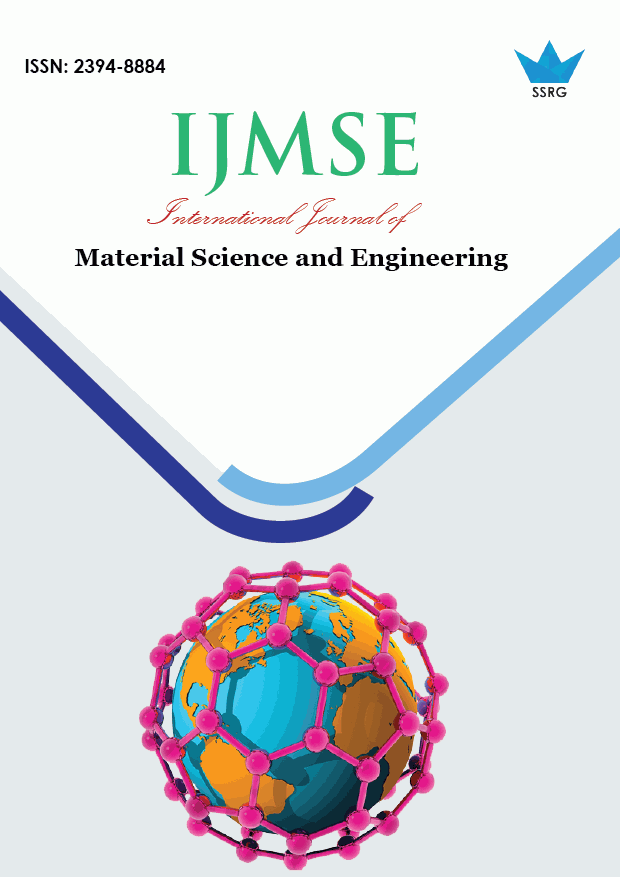Low-Cost Synthesis of CaCO3 Microspheres for High Performance Radiative Cooling Paint: A Facile Approach Using Household Chemicals

| International Journal of Material Science and Engineering |
| © 2025 by SSRG - IJMSE Journal |
| Volume 11 Issue 3 |
| Year of Publication : 2025 |
| Authors : Piyu Nargund |
How to Cite?
Piyu Nargund, "Low-Cost Synthesis of CaCO3 Microspheres for High Performance Radiative Cooling Paint: A Facile Approach Using Household Chemicals," SSRG International Journal of Material Science and Engineering, vol. 11, no. 3, pp. 5-10, 2025. Crossref, https://doi.org/10.14445/23948884/IJMSE-V11I3P102
Abstract:
This study presents a facile synthesis method for calcium carbonate (CaCO3) microspheres using readily available household chemicals and their application in radiative cooling paints, achieving significant sub-ambient cooling. At room temperature, the microspheres are synthesized through controlled precipitation using sodium carbonate, calcium chloride, and citric acid. Two paint formulations are developed using acetone-based dispersions with either acrylic or hot glue binders. Field-testing under direct sunlight at 35°C ambient temperature demonstrates remarkable cooling performance, with the acrylic-based paint achieving 4°C below ambient temperature and the hot glue-based formulation reaching 3°C below ambient, compared to a control showing 0.5°C above ambient. The synthesis method employs multiple reaction times (1, 5, and 8-10 minutes) to generate varied particle morphologies. The optimal formulation combines 7g of CaCO3 pigment per 12ml of acetone-water-acrylic base. This work demonstrates that high-performance radiative cooling paints can be produced using low-cost, accessible materials, offering potential for widespread adoption in passive cooling applications. The achieved cooling performance compares favorably with commercial formulations while maintaining significantly lower production costs.
Keywords:
Calcium carbonate, Microspheres, Passive cooling, Radiative cooling, Synthesis.
References:
[1] Xiaobo Yin et al., “Terrestrial Radiative Cooling: Using the Cold Universe as a Renewable and Sustainable Energy Source,” Science, vol. 370, no. 6518, pp. 786-791, 2020.
[CrossRef] [Google Scholar][Publisher Link]
[2] Jyotirmoy Mandal et al., “Hierarchically Porous Polymer Coatings for Highly Efficient Passive Daytime Radiative Cooling,” Science, vol. 362, no. 6412, pp. 315-319, 2018.
[CrossRef] [Google Scholar] [Publisher Link]
[3] Xiangyu Li et al., “Ultrawhite BaSO4 Paints and Films for Remarkable Daytime Subambient Radiative Cooling,” ACS Applied Materials & Interfaces, vol. 13, no. 18, pp. 21733-21739, 2021.
[CrossRef] [Google Scholar] [Publisher Link]
[4] Meijie Chen et al., “Passive Daytime Radiative Cooling: Fundamentals, Material Designs, and Applications,” EcoMat, vol. 4, no. 1, 2022.
[CrossRef] [Google Scholar] [Publisher Link]
[5] Joseph Peoples et al., “A Strategy of Hierarchical Particle Sizes in Nanoparticle Composite for Enhancing Solar Reflection,” International Journal of Heat and Mass Transfer, vol. 131, pp. 487-494, 2019.
[CrossRef] [Google Scholar] [Publisher Link]
[6] Yao Zhai et al., “Scalable-Manufactured Randomized Glass-Polymer Hybrid Metamaterial for Daytime Radiative Cooling,” Science, vol. 355, no. 6329, pp. 1062-1066, 2017.
[CrossRef] [Google Scholar] [Publisher Link]
[7] Tian Li et al., “A Radiative Cooling Structural Material,” Science, vol. 364, no. 6442, pp. 760-763, 2019.
[CrossRef] [Google Scholar] [Publisher Link]
[8] Sarun Atiganyanun et al., “Effective Radiative Cooling by Paint-Format Microsphere-Based Photonic Random Media,” ACS Photonics, vol. 5, no. 4, pp. 1181-1187, 2018.
[CrossRef] [Google Scholar] [Publisher Link]
[9] Semra Kirboga, and Mualla Oner, “Effect of the Experimental Parameters on Calcium Carbonate Precipitation,” Chemical Engineering Transactions, vol. 32, pp. 2119-2124, 2013.
[CrossRef] [Google Scholar] [Publisher Link]
[10] Juan Diego Rodriguez-Blanco, Samuel Shaw, and Liane G. Benning, “The Kinetics and Mechanisms of Amorphous Calcium Carbonate (ACC) Crystallization to Calcite, Via Vaterite,” Nanoscale, vol. 3, pp. 265-271, 2011.
[CrossRef] [Google Scholar] [Publisher Link]
[11] Kh. Nurul Islam et al., “Characterisation of Calcium Carbonate and Its Polymorphs from Cockle Shells,” Powder Technology, vol. 213, no. 1-3, pp. 188-191, 2011.
[CrossRef] [Google Scholar] [Publisher Link]
[12] Hua Bao et al., “Double-Layer Nanoparticle-Based Coatings for Efficient Terrestrial Radiative Cooling,” Solar Energy Materials and Solar Cells, vol. 168, pp. 78-84, 2017.
[CrossRef] [Google Scholar] [Publisher Link]
[13] Xiao Xue et al., “Creating an Eco-Friendly Building Coating with Smart Subambient Radiative Cooling,” Advanced Materials, vol. 32, no. 42, 2020.
[CrossRef] [Google Scholar] [Publisher Link]
[14] Aaswath P. Raman et al., “Passive Radiative Cooling Below Ambient Air Temperature Under Direct Sunlight,” Nature, vol. 515, pp. 540-544, 2014.
[CrossRef] [Google Scholar] [Publisher Link]
[15] Jeon S., Son S., Lee S. Y., Chae D., Bae J. H., Lee H., and Oh S. J., "Multifunctional Daytime Radiative Cooling Devices with Simultaneous Light-Emitting and Radiative Cooling Functional Layers," ACS Applied Materials & Interfaces, vol. 12, no. 49, pp. 54763-54772, 2020.
[CrossRef] [Google Scholar] [Publisher Link]
[16] Zhifeng Huang, and Xiulin Ruan, “Nanoparticle Embedded Double-Layer Coating for Daytime Radiative Cooling,” International Journal of Heat and Mass Transfer, vol. 104, pp. 890-896, 2017.
[CrossRef] [Google Scholar] [Publisher Link]
[17] A. Aili et al., “Selection of Polymers with Functional Groups for Daytime Radiative Cooling,” Materials Today Physics, vol. 10, 2019.
[CrossRef] [Google Scholar] [Publisher Link]
[18] Jianing Song et al., “Durable Radiative Cooling Against Environmental Aging,” Nature Communications, vol. 13, 2022.
[CrossRef] [Google Scholar] [Publisher Link]
[19] Minghao Dong et al., “Nighttime Radiative Cooling in Hot and Humid Climates,” Optics Express, vol. 27, no. 22, pp. 31587-31598, 2019.
[CrossRef] [Google Scholar] [Publisher Link]
[20] Junwei Liu et al., “Daytime Radiative Cooling with Clear Epoxy Resin,” Solar Energy Materials and Solar Cells, vol. 207, 2020.
[CrossRef] [Google Scholar] [Publisher Link]
[21] Xiangyu Li et al., “Full Daytime Sub-ambient Radiative Cooling with High Figure of Merit in Commercial-like Paints,” arXiv preprint arXiv:2008.03372, 2020.
[CrossRef] [Google Scholar] [Publisher Link]
[22] Karthik Sasihithlu et al., “Achieving Passive Daytime Radiative Cooling via TiO₂/PDMS Coating,” arXiv preprint arXiv:2202.09598, 2022.
[CrossRef] [Publisher Link]
[23] Jyotirmoy Mandal et al., “Paints as a Scalable and Effective Radiative Cooling Technology for Buildings,” Joule A Cell Press Journal, vol. 4, no. 7, pp. 1350-1356, 2020.
[Google Scholar] [Publisher Link]
[24] Cheng Ziming et al., “Low-Cost Radiative Cooling Blade Coating with Ultrahigh Visible Light Transmittance and Emission Within an Atmospheric Window,” Solar Energy Materials and Solar Cells, vol. 213, 2020.
[CrossRef] [Google Scholar] [Publisher Link]

 10.14445/23948884/IJMSE-V11I3P102
10.14445/23948884/IJMSE-V11I3P102